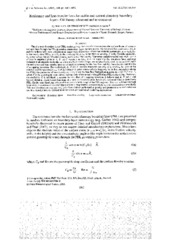| dc.description.abstract | The planetary boundary layer (PBL) resistance and heat-transfer laws express the surface fluxes of momentum and heat through the PBL governing parameters. Since the late sixties, the dimensionless coefficients (A, B and C) in these laws were considered as single-valued functions of internal stability parameters: = u*/|f|Ls in the steady state PBLs, or h/Ls in the evolving PBLs ( u* is the friction velocity, f is the Coriolis parameter, Ls is the Monin-Obukhov length, and h is the PBL depth). Numerous studies revealed very wide spread of data in empirical plots of A, B and C versus μ or h/Ls. It is not surprising that the above laws, although included in all modern textbooks on boundary-layer meteorology, are not practically used. In the present paper the resistance and heat-transfer laws are revised accounting for the free-flow stability, baroclinicity and the rise of capping inversion. The coefficients A, B and C become functions not only of μ or h/Ls, but also of the external stability parameter µn=N/|f| (where N is the Brunt Väisälä frequency in the free atmosphere above the PBL), the parameter of baroclinicity µΓ=Γ/N (or the free-flow Richardson number Ri = (N/Γ)2 = μΓ-2, where Γ is the geostrophic wind shear), and the ratio of the actual h and the equilibrium PBL depths h/hE. Moreover the coefficient C is redefined to account for the effect of capping inversion. It follows that A, B and C can be considered as single-valued functions of μ only in the steady-state, barotropic, nocturnal (that is short-lived) PBL. On the contrary, the advanced laws cover a wide range of the PBL regimes. They are validated through large-eddy simulation (LES) of different types of PBLs: truly neutral, conventionally neutral, nocturnal and long-lived. This new development explains why prior formulations performed so poor and promotes advanced resistance and heat transfer laws as a practical tool for use in environmental modelling applications. | en_US |
